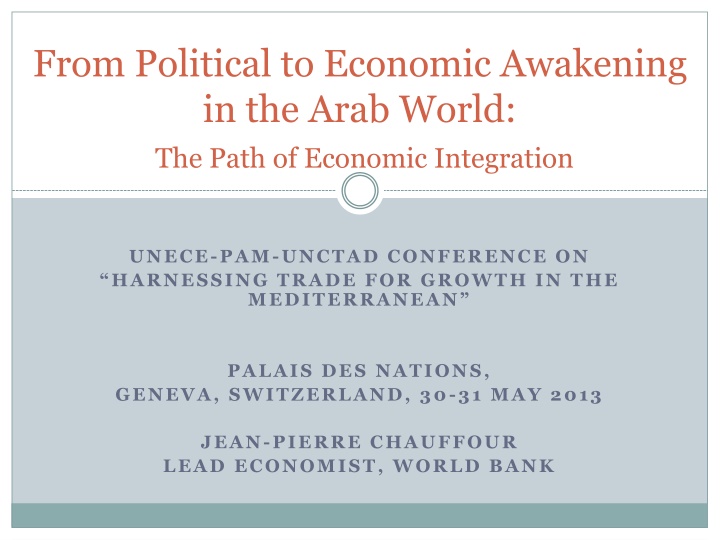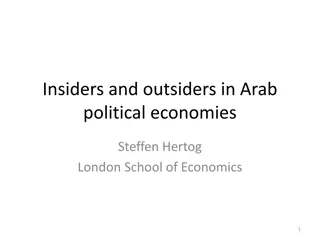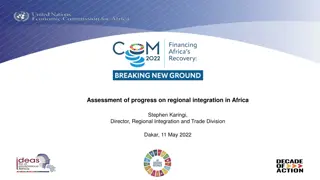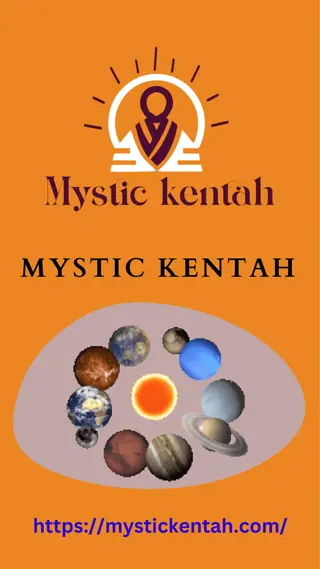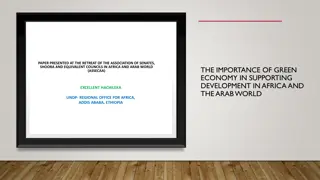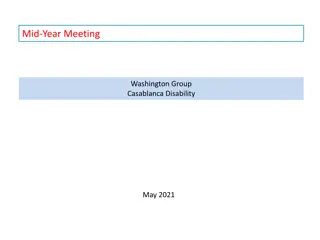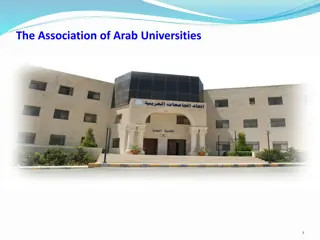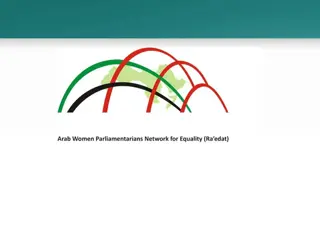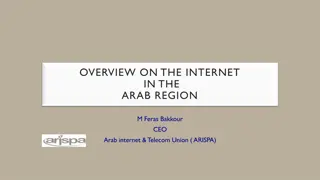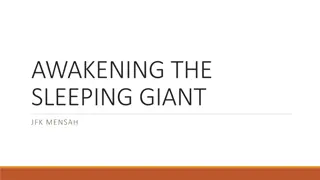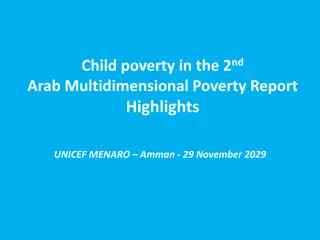Economic Integration in the Arab World: Path to Awakening
The journey from political to economic awakening in the Arab world is explored, focusing on challenges such as soaring youth population, high youth unemployment rates, and insufficient job creation. Policy instruments and the role of trade and investment in addressing these issues are also discussed.
Uploaded on Mar 09, 2025 | 1 Views
Download Presentation

Please find below an Image/Link to download the presentation.
The content on the website is provided AS IS for your information and personal use only. It may not be sold, licensed, or shared on other websites without obtaining consent from the author.If you encounter any issues during the download, it is possible that the publisher has removed the file from their server.
You are allowed to download the files provided on this website for personal or commercial use, subject to the condition that they are used lawfully. All files are the property of their respective owners.
The content on the website is provided AS IS for your information and personal use only. It may not be sold, licensed, or shared on other websites without obtaining consent from the author.
E N D
Presentation Transcript
From Political to Economic Awakening in the Arab World: The Path of Economic Integration UNECE-PAM-UNCTAD CONFERENCE ON HARNESSING TRADE FOR GROWTH IN THE MEDITERRANEAN PALAIS DES NATIONS, GENEVA, SWITZERLAND, 30-31 MAY 2013 JEAN-PIERRE CHAUFFOUR LEAD ECONOMIST, WORLD BANK
Background Deauville Partnership 2 In wake of Arab Spring, Deauville Summit of the G8 (April 2011) establishes a Partnership between Deauville Partners: G8, Kuwait Qatar, Saudi Arabia, Turkey, UAE, and 9 associated international and regional financial institutions Arab countries in transition: Egypt, Jordan, Morocco, Tunisia, and later Libya and Yemen Deauville Partnership commissions an analytical report to provide an appropriate framework to enhance trade and FDI
Youth Unemployment Rates 4 MENA has highest youth unemployment rate in the world (%) 40 35 30 25 20 15 10 5 0 North Africa Middle East SA LAC World Sub Saharan Africa South Asia East Asia Source: Regional Economic Developments and Prospects, MENA, World Bank, 2011
Insufficient economic growth to create enough jobs 6 Source: From Privilege to Competition, World Bank, 2009
What are the available policy instruments ? 7 Fiscal policy Lower revenues Higher social expenditures Monetary and exchange rate policies Small open economies Declining foreign exchange reserves Structural policy Subsidies Pension Domestic competition
Could Trade & Investment be part of the answer? 8 Trade. MENA could produce more if it were to export more. Excluding oil exports, the MENA region of over 400 million people exports roughly the same amount as Switzerland FDI. Excluding oil and real estate investment, FDI in manufacturing the type of investment rich in employment has remained marginal, accounting for just a fifth of all FDI inflows in the region
Flat share of global exports of goods and services 4 100% 1% 2% 3% 1% 2% 3% 6% 5% 90% 6% 1% 3% 6% 6% 11% 80% 17% LDCSSA 70% LDCouthSAsia 60% LDCMNA 50% LDCLAC 84% 40% 77% LDCEurope 64% 30% LDCEastAsia 20% High income 10% 0% 1988 1998 2008 Source: Regional Economic Developments and Prospects, MENA, World Bank, 2011
Limited intra-MENA integration Measured by nonoil exports 5 MENA MENA 27% RoW 15% RoW 10% MENA 29% USA 4% USA 6% Asia 14% EU 41% Asia 25% EU 29% 1998 2008 Source: World Bank (staff calculations), 2011
FDI inflows surged 6 In percent of GDP 14 FDI, 1990s FDI, 2000s 12 10 8 6 4 2 0 -2 Source: Regional Economic Developments and Prospects, MENA, World Bank, 2011
Mainly in real estate and mining 7 Share of greenfield FDI inflows by sector 100% 90% 80% Tourism 70% 60% Real Estate 50% Other Services 40% Mining 30% Manufacturing 20% 10% 0% Egypt Jordan Libya Morocco Tunisia Source: Regional Economic Developments and Prospects, MENA, World Bank, 2011
Domestic private investment has not yet taken off 13 Source: From Privilege to Competition, World bank, 2009
A complex business environment (and indicators hide uneven application of rules) 14 Doing Business 2012 Ratings for 2011 (and Libya Estimates, 2010) 200 175 Starting a business 150 Dealing with construction permits Getting electricity 125 Registering property 100 Getting credit Protecting investors 75 Paying taxes Trading across borders 50 Enforcing contracts 25 Resolving insolvency 0 Egypt Jordan Morocco Tunisia Libya (estimates, not official DB rank) Source: Doing Business in a More Transparent World, Doing Business 2012, World Bank Group
Overall lack of competitiveness 15 Global Competitiveness Index Institutions 7 Innovation Infrastructure 6 5 Macroeconomic environment 4 Business sophistication 3 2 Egypt 1 Jordan Health and primary education Market size 0 Morocco Tunisia Higher education and training Technological readiness Financial market development Goods market efficiency Labor market efficiency Source: Global Competitiveness Report, 2011
Top 5 features of successful emerging economies: 16 committed, credible, and capable governments maintain macroeconomic stability exploit the world economy let markets allocate resources muster high rates of saving and investment Source: Growth Commission Report (2008)
How to do it? Leadership and Vision 17 Leadership in both Partnership Countries and partner countries is needed to provide a credible long term vision: the 4 freedom agenda Leaders will need to promote sustained growth and job creation, in a framework of common values of peace and stability; cannot focus exclusively on short-term priorities: need to demonstrate credibility
The main proposal of the report 12 Objective. Expanding market opportunities while undertaking policy reforms needed to seize them, including trade facilitation measures Expected Result. Deeper integration as an anchor for meritocratic domestic reform, sustainable economic growth and jobs creation
Outline of the report 19 Section 1: The new global Trade & FDI landscape dealing with the fragmentation of production (i.e., global value chains) Section 2: Market access and rules creating opportunities to trade and invest across borders cheaply, securely and predictably Section 3: Competitiveness and diversification implementing complementary domestic reforms of the business climate Section 4: Trade facilitation and trade finance oiling the Trade & FDI engine especially for SMEs Section 5: Inclusiveness, equity and sustainability making economic integration a sustainable and inclusive long term political economy proposition
What could Deauville Partners do? 31 The EU could deepen its trade relationships with Egypt, Jordan, Morocco, and Tunisia with the effective implementation of the proposed deep and comprehensive FTAs (DCFTAs). In a coordinated and coherent approach, and on the basis of its growing political and economic influence in the region, Turkey could similarly deepen its existing Association Agreements. The GCC could strengthen its relationship with Egypt and Tunisia (Jordan and Morocco have been officially invited to join the GCC), in the framework of a deepened cooperation with the Agadir agreement. The USA could (a) increase the value of its existing agreements with Jordan and Morocco, and (b) invite Tunisia and, once the appropriate circumstances are in place, Egypt to enter into FTAs.
What must Deauville Partnership countries (Egypt, Jordan, Tunisia, Morocco, Libya) do? 33 Parallel implementation of complementary domestic policies as part of a comprehensive reform agenda to improve competitiveness critical to take advantage from enhanced market access Put in place institutional mechanisms to negotiate, implement, and evaluate the process of regulatory and policy convergence
Political economy challenges 22 Past political legacy with Arab authoritarian regimes Lack of credibility and trust among partners EU in economic and financial turmoil Little room for financial support Unclear policy direction and vision in Arab countries Populist policies and shortermism Pressing political issues dwarfing all economic priorities
35 12000 Emulating Turkey 10000 Since anchoring domestic reforms in a comprehensive integration process with the EU, Turkey has created 3 million new jobs 8000 Morocco Tunisia 6000 Turkey Jordan Egypt 4000 2000 0
Thank you Available at https://openknowledge .worldbank.org/handle /10986/12221
